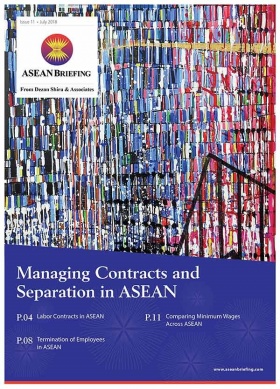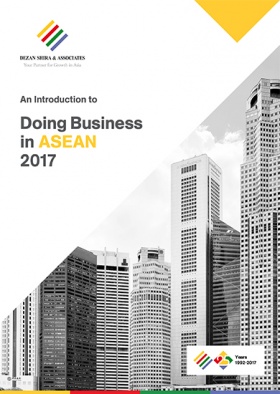Women in the Workforce in ASEAN – Part One
In part one of this two part series, ASEAN Briefing takes a closer look at women in the workplace regionally. The second part can be found here.
The employment level for women throughout the ASEAN region is important for foreign investors and international companies to understand and anticipate. Indeed, the importance of female penetration in the labor force for overall economic growth is something that could affect the prospects of multinational companies investing in any region, and is especially important in emerging economic regions such as South East Asia.
An increase in employment of women can be an indicator of how a good an economy is doing overall, as well as future prospects for available labor. Such factors can be game changers when selecting an investment location. As such, this article will profile the role of women in the labor force three large ASEAN economies: Malaysia, Singapore, and Vietnam.
Malaysia
Malaysia is one of the ASEAN countries lagging behind others in the employment level of women. The female labor force participation rate in this country has reached 44 percent of the country’s female population age 15 and up over the past 15 years. The main reason for the lack of women in the workforce is due to child-bearing. Most women stop working to look after their children because of the lack of child-care facilities in Malaysia. Two-thirds of women said that family is the main reason for leaving workforce and alleviating child-care strains would help this.
There have been both government and company incentives to lure women back into the workforce. The government has collaborated with companies to increase child-care facilities. Prime Minister Najib Razak has offered tax incentives to companies that establish nurseries and allow flexible work arrangements to encourage women to resume their careers. The Malaysian unit of Citibank opened child-care center for employees and CIMB Group Holdings Bank, which is the second largest bank in Malaysia, has a child-care center, car parks for pregnant women and breast-feeding rooms for female employees. General Electric offer benefits such as flexible working hours and extended maternity leave. All of which are examples of ways in which the country is trying to boost Southeast Asia’s lowest female workforce participation rate.The decrease of women in the workplace has led to a clear imbalance in the workforce with women holding just seven percent board seats of companies. However, the Malaysian government is embarking on more sustainable efforts to bring women back into the workforce. This will not only benefit the country of Malaysian, an increase in female employment will also benefit companies.
Singapore
Equality of women continues to be vital to Singapore’s economic progress. According to Singapore’s Labor force statistics last year, the employment rate for women is at one of the highest levels with a staggering 76 percent for the prime working ages of 25 – 54 years old. However, like in Malaysia, there has been a decrease of employed women specifically in their 30s because of child-rearing and care-giving reasons.
Resident Labor Force participation rate rose for the third successive year to a new high of 67 percent in 2014, driven by ongoing increases of women residents. Employment rate rose to a new high as more women got into the labor force amid a tight labor market and low unemployment as a whole. Rise in employment rate of women is a reflection of how good the economy is doing.
Today, the Singaporean woman is often viewed as equal to her male counterpart. There are many women doctors, lawyers, bankers, entrepreneurs, office workers and legislators in Singapore. On the contrary, some women are not equally paid as males for the same job similar to the United States and other countries. Women are also underrepresented at senior management levels. Nonetheless, Singapore has been doing fairly well in insuring that more women are being employed in the workforce.
Some solutions presented to ensure more female employment include companies being more open-minded, consultative and creative in considering alternative work plans specifically targeted at female work-life balance.Vietnam
According to the United Nation’s International Labor Organization, there are about 72 percent of women in the labor force in Vietnam, which also means that a lot more Vietnamese women have jobs then most of the other countries around the globe. However, gender gap has expanded in Vietnam where the labor force participation of women still stands high in the world.
Women in Vietnam make up a large part of the Vietnamese workforce. Women are a part of every industry in this country. However, like Singapore and most other countries, women make less than their male counterparts. Even with these obstacles women in Vietnam are staying strong and continuing to hold and succeed in important jobs. This speaks volume about Vietnam’s economy.
What does Improved Female Employment mean for International Companies?
Female employment has the power to enhance a company’s relations with the local community and with other business partners. This can help companies when conducting their business activities. Usha Rao-Monari, Director of International Finance Corporation (IFC) Sustainable Business Advisory stated, “Women’s participation is critical to meet the demand for skilled labor in emerging markets. Investing in women’s employment is a win-win for all, strengthening both companies and community and changing the face of the global economy”.
As a result, hiring more women can enhance a company’s workforce by making sure it is representative of its customer base and it can provide more insights into consumer preferences. Thus, understanding women’s penetration in the labor force is a key insight which decision makers must not overlook when selecting an investment destination in ASEAN.
About Us
ASEAN Briefing is published by Asia Briefing, a subsidiary of Dezan Shira & Associates. We produce material for foreign investors throughout Asia, including China, India, Indonesia, Russia, the Silk Road & Vietnam. For editorial matters please contact us here and for a complimentary subscription to our products, please click here.
Dezan Shira & Associates provide business intelligence, due diligence, legal, tax and advisory services throughout the ASEAN and Asia. We maintain offices in Singapore, as well as Hanoi & Ho Chi Minh City, and maintain Alliance offices in Bangkok, Jakarta, Kuala Lumpur and Manila as well as throughout China, South-East Asia, India and Russia. For assistance with ASEAN investments into any of the featured countries, please contact us at asean@dezshira.com or visit us at www.dezshira.com
- Previous Article Breaking the Mold: FDI Opportunities in ASEAN’s Plastics Industry
- Next Article Renewable Energy and Investment in ASEAN









